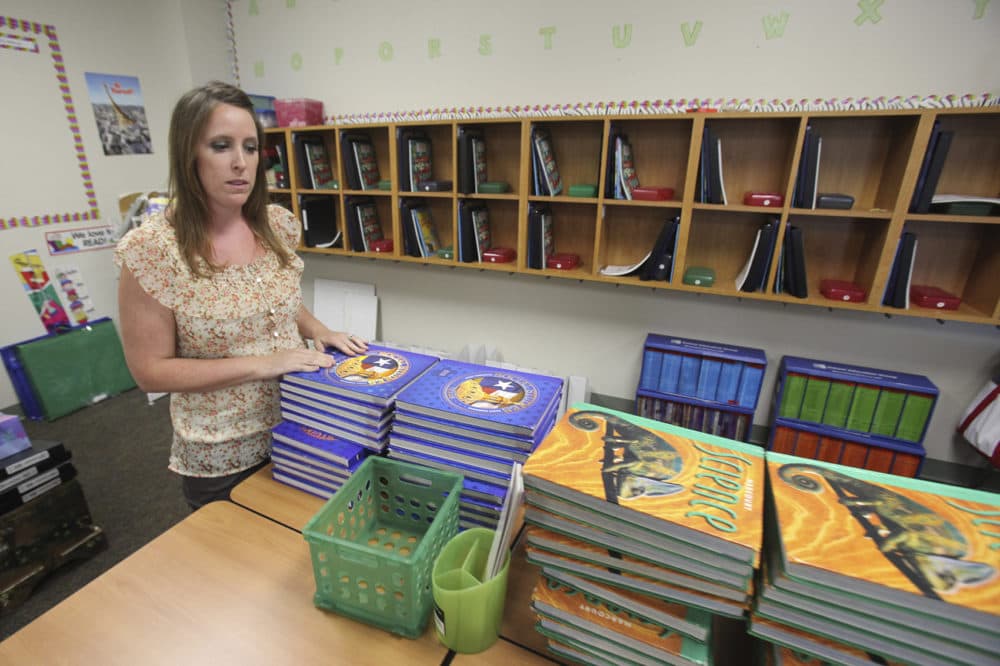Advertisement
How Political Divides Shape U.S. History Lessons
Resume
Partisan politics are making their way into school textbooks, reports The New York Times. We dig into the report.
Guests
Dana Goldstein, education reporter for The New York Times. (@DanaGoldstein)
Albert Broussard, professor of history at Texas A&M University. Co-author of numerous textbooks for high school students adapted nationwide. (@historyTAMU)
Kerry Green, 11th grade U.S. history teacher and social studies department chair of Sunnyvale High School, in a suburb of Dallas, Texas.
From The Reading List
The New York Times: "Two States. Eight Textbooks. Two American Stories." — "The textbooks cover the same sweeping story, from the brutality of slavery to the struggle for civil rights. The self-evident truths of the founding documents to the waves of immigration that reshaped the nation.
"The books have the same publisher. They credit the same authors. But they are customized for students in different states, and their contents sometimes diverge in ways that reflect the nation’s deepest partisan divides.
"Hundreds of differences — some subtle, others extensive — emerged in a New York Times analysis of eight commonly used American history textbooks in California and Texas, two of the nation’s largest markets.
"In a country that cannot come to a consensus on fundamental questions — how restricted capitalism should be, whether immigrants are a burden or a boon, to what extent the legacy of slavery continues to shape American life — textbook publishers are caught in the middle. On these questions and others, classroom materials are not only shaded by politics, but are also helping to shape a generation of future voters.
"Conservatives have fought for schools to promote patriotism, highlight the influence of Christianity and celebrate the founding fathers. In a September speech, President Trump warned against a 'radical left' that wants to 'erase American history, crush religious liberty, indoctrinate our students with left-wing ideology.'
"The left has pushed for students to encounter history more from the ground up than from the top down, with a focus on the experiences of marginalized groups such as enslaved people, women and Native Americans."
The New York Times: "I Read 4,800 Pages of American History Textbooks" — "For the past five months, my small cubicle has been clogged with an unusual sight in a newsroom: 43 middle school and high school American history textbooks.
"Colleagues walking by would often grimace and say something like: 'Ugh. This reminds me of studying for the A.P. U.S. History exam.'
"But as an education reporter on the National desk, I relished the painstaking task I had set out for myself: reading about 4,800 pages of mostly sterile, written-by-committee prose to figure out what American teenagers are learning about our nation’s history in this deeply divided time, and how those lessons differ across the country.
"(A colleague on the desk, Adeel Hassan, offered a crucial assist by reading and taking notes on an additional 1,600 pages.)
"I embarked on this project after reporting on how difficult it had been for policymakers in a single state — Michigan — to come to a consensus on how to teach American history. I wondered how this politicized process was playing out in other places across the country, and within the halls of textbook publishing companies.
"We decided to focus on four sets of textbooks from three of the nation’s major educational publishers: McGraw-Hill, Pearson and Houghton Mifflin Harcourt. Each of the books had a recently published edition customized for students in Texas and another edition customized for students in California, allowing us to see how a conservative and a liberal state are teaching history differently."
The New York Times: "What California’s History Textbooks Tell Us" — "It’s a rivalry that feels at once inevitable and arbitrary, timeless and very rooted in our hyperpartisan era: California versus Texas.
"Over the weekend, my colleague Dana Goldstein published an in-depth analysis of American history textbooks used in California and Texas schools. Though they came from the same publishers, they’re different in ways that are informed by politics.
"On Monday, I talked with Dana about the project, why she picked California and Texas, and what she’ll be watching going forward. Here’s our conversation:
"Can you briefly tell me a bit more about how the project came about?
"I got the idea for this story at the very beginning of 2019, when I did a previous story, which was about the state of Michigan and how it had a huge battle between conservatives and liberals about how to define what should be taught in social studies classrooms.
"And while I was doing that piece, I visited some schools and I went into a history classroom and I saw this teacher had a textbook and it was completely marked up, like she had stuck sticky tags all over it, and underlined and highlighted stuff. And I thought, 'The textbook is still important.' "
This program aired on January 16, 2020.

